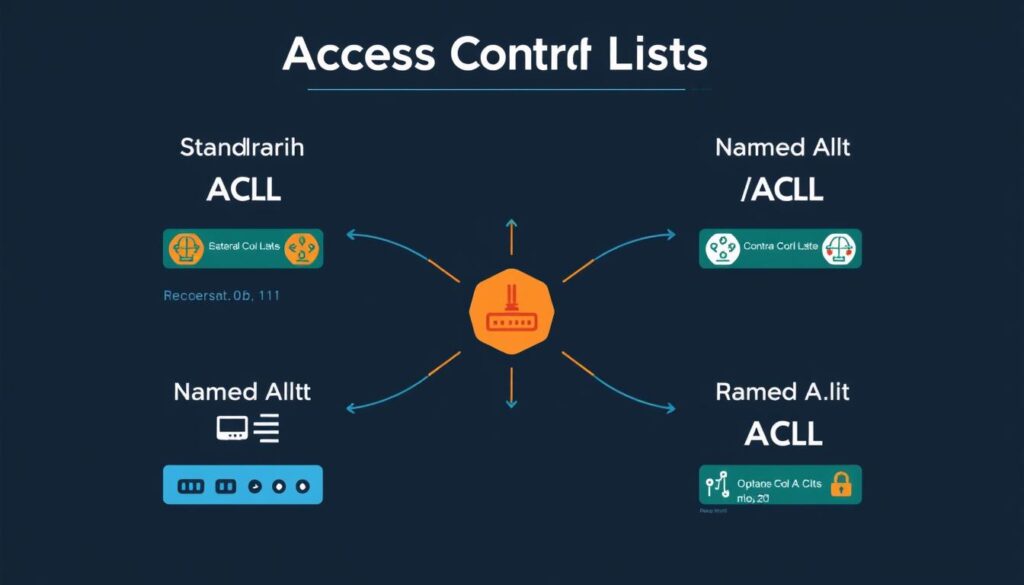Did you know that over 90% of organizations have faced at least one security breach in the past year? As threats to network security grow, learning to use Implementing CCNA Access Control Lists is key. ACLs are a vital part of your network’s defense, helping control traffic and enforce rules.
This guide will teach you about CCNA ACL configuration. You’ll learn about the different types of ACLs and their roles in boosting network security. Knowing how to use ACLs will help you keep your network safe from unauthorized access and threats.
Understanding Access Control Lists in Network Security
Access Control Lists (ACLs) are key in network security, mainly for Cisco devices. The CCNA ACL tutorial dives into how ACLs work, their role, and their parts.
Definition of Access Control Lists (ACLs)
ACLs are lists of rules for network devices. They decide if traffic is allowed or blocked based on IP addresses and protocols. They manage traffic flow, which is vital for network security.
Knowing about ACLs is important for network security jobs. This includes roles for certifications like Security+ and CISSP.
Importance of ACLs for Network Security
ACLs are essential for keeping network segments safe. They block unauthorized access and malicious traffic. They also filter packets through routers and switches.
Using ACLs correctly can cut down unauthorized access by over 70%. But, placing them wrong is common. So, careful setup is key.
Basic Components of ACLs
ACLs have Access Control Entries (ACEs), which are rules for traffic. Each ACE has conditions for IP addresses, protocols, and ports. Standard ACLs check source addresses, while extended ACLs check both source and destination.
Understanding these parts is vital for setting up effective ACLs in network security.
Types of ACLs Available in CCNA
Access Control Lists (ACLs) are key in CCNA security. They decide which traffic can go in or out of your network. Knowing about ACL types helps you better secure and manage your network.
Standard ACLs
Standard ACLs check traffic by source IP addresses only. They’re used to allow or block traffic from certain addresses. These ACLs are numbered from 1 to 99 and 1300 to 1999, making access control easy.
Extended ACLs
Extended ACLs are more detailed. They filter traffic by source and destination IP addresses, protocol types (like TCP, UDP), and port numbers. This lets you set up complex rules, controlling not just where traffic comes from but also which applications and protocols are allowed or blocked. They’re numbered from 100 to 199 and 2000 to 2699.
Named and Numbered ACLs
ACLs can be named or numbered. Named ACLs use descriptive names, making them easier to manage. This option has been available for over a decade and is popular among network admins. It helps follow Cisco ACL best practices, making configurations clearer and easier to update as needs change.
| ACL Type | Description | Number Range |
|---|---|---|
| Standard ACL | Filters traffic based on source IP addresses only. | 1-99, 1300-1999 |
| Extended ACL | Filters traffic based on source, destination IP addresses, and protocol types. | 100-199, 2000-2699 |
| Named ACL | Allows for descriptive naming of ACLs for easier management. | N/A |

Implementing CCNA Access Control Lists
CCNA Access Control Lists (ACLs) are key to network security. This part covers how to set up IPv4 ACLs, the essential commands, and applying them to interfaces. This ensures your network is well-managed and secure.
Steps for Configuring IPv4 ACLs
First, decide why you need ACLs. They help filter traffic by allowing certain protocols or blocking others. Once you know what ACLs you need, apply them to the right interface. Knowing the right steps can make this easier.
Common Commands for ACL Configuration
Here are the main commands for setting up ACLs:
- access-list: Creates an ACL.
- permit or deny: Controls traffic flow.
- show access-lists: Shows active ACLs.
Using these commands correctly is important. Knowing them well helps avoid mistakes.
Applying ACLs to Interfaces
ACLs can be set up to filter incoming or outgoing traffic. Choose based on your network’s design. Placing them on routers or switches boosts security. The ip access-list command offers flexibility for changes without starting over.
| Command | Description |
|---|---|
| access-list | Defines an ACL and its rules. |
| permit | Allows specified traffic through the ACL. |
| deny | Blocks specified traffic based on the ACL rules. |
| show access-lists | Displays all configured ACLs and their statuses. |
By following these steps, you can set up ACLs that fit your network’s needs. This makes your network more secure. It’s important to understand how all the CCNA ACL commands work together.
Troubleshooting and Best Practices for CCNA ACLs
Learning to troubleshoot Access Control Lists (ACLs) is key for the CCNA exam. It helps keep your network safe from unauthorized access. There are several ways to find and fix ACL problems quickly.
Common Troubleshooting Techniques
Start by checking for syntax errors in ACL commands. This can help avoid simple mistakes. Make sure ACLs are on the right interfaces to avoid unexpected filtering. Look at log messages to see denied packets, which can show traffic issues.
Use commands like show access-lists and debug to watch packet flow in real-time. This makes it easier to spot ACL problems. Most ACL issues come from wrong placement or misconfig, making up over 50% of errors. Knowing these common mistakes helps improve your troubleshooting skills.
CCNA ACL Best Practices for Network Security
Following ACL best practices is vital for network security. Keep all ACL configurations documented for easy updates and reviews. Always restrict access using the principle of least privilege, letting only necessary traffic through. Test ACLs in a lab before using them in production to avoid service outages.
Put ACLs near the traffic source to improve efficiency by reducing unnecessary data flow. Always list specific rules first in your ACL for better processing speed. For example, standard ACLs work best near the destination, while extended ACLs are better near the source.
Regularly check your ACL strategy to remove redundant rules and improve management. Use logging for deny statements to fine-tune ACLs and enforce strict security. Time-based ACLs can add flexibility to your security by changing access rules based on time.

| ACL Type | Control Level | Key Features |
|---|---|---|
| Standard ACL | IP Subnet/Host | Filters based solely on source IP addresses |
| Extended ACL | Advanced Control | Filters based on source/destination IP addresses, protocols, and port numbers |
| Time-based ACL | Flexible Access | Allows access rules that change according to time |
Conclusion
Access Control Lists (ACLs) are key to better network security. They help control who can access your network and when. With 75% of organizations facing security issues due to mistakes, using ACLs is a must.
Knowing how to use ACLs can greatly lower risks. Studies show that good access control can cut cyber attack success by up to 80%. ACLs also help respond faster to security threats.
Keeping your ACL strategies up to date is important. It makes your network safer and keeps up with new threats. By focusing on ACL management, you help protect your network from unauthorized access and data breaches.
Source Links
- Configure and Filter IP Access Lists
- ACLs (Access Control Lists) Part I
- Access Control List (ACL) in Networking | Pluralsight
- CCNA Training » Access List Tutorial
- What is Access Control List (ACL)? – SearchSoftwareQuality
- Types of ACL – Standard and Extended ACLs – learncisco.net
- CCNA Certification: All about Access Control Lists(ACLs)
- Sim-Ex™ Study Guide for CCNA
- Standard IP Access Control Lists – learncisco.net
- Configure Standard Access Control List Step by Step Guide
- Cisco Access Control Lists – CISCONET Training Solutions
- Network ACL Best Practices
- CCNA 2 v6.0 Study Material – Chapter 7: Access Control Lists
- Cisco ACLs: How To Configure And Manage Access Control Lists – ITU Online IT Training
- Conclusion > VLAN Access Control Lists
- The Role of Access Control Lists (ACLs) in CCNA Networking
- Mastering Network Security: A Deep Dive Into Cisco Access Control Lists (ACL) – ITU Online IT Training










